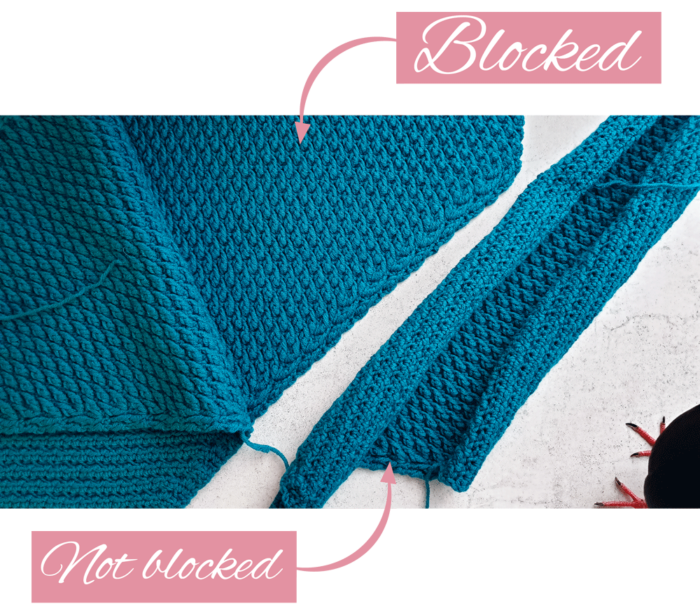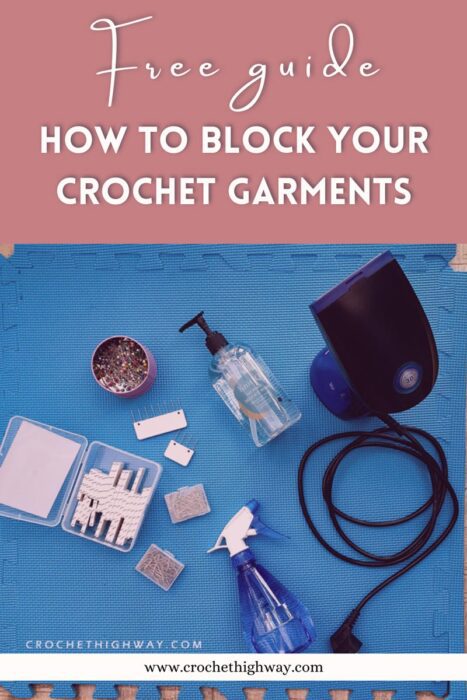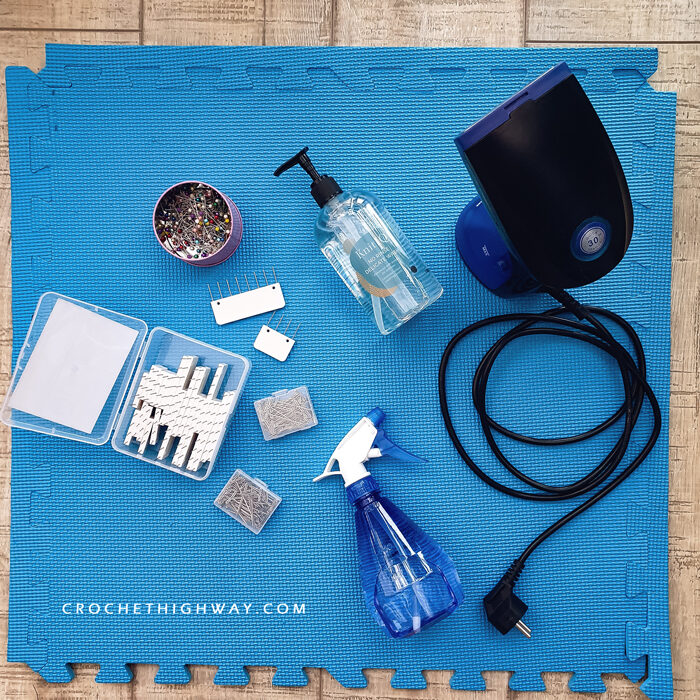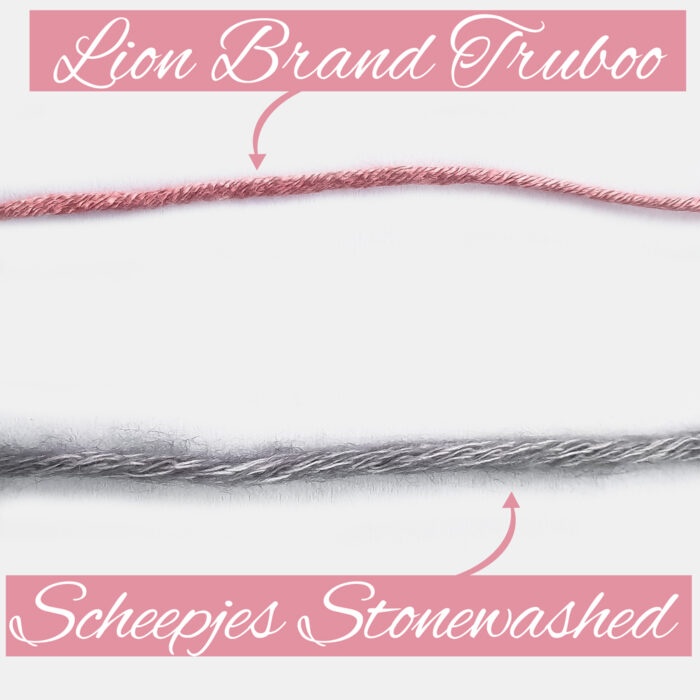How to block your crochet garments
A comprehensive & succinct(ish) guide to blocking your crochet and knit projects

Is blocking hard? Do I have to block everything I crochet? And do I really need to block my crochet sweater?
No. No. And a resounding YES!
Welcome to my comprehensive guide about blocking, where I try to pull together everything I know and have researched about blocking in a succinct(ish) manner that will be an absolute pleasure for you to go over. Read all the way to the end for a bonus tip!
Let’s cut straight to the chase, shall we?
Disclaimer: This post is not sponsored. I purchased all items with my own money and all opinions are my own based on my experience. Some links on this page are affiliate links. This means that, if you click through the links and make a purchase, I may earn a small commission at no additional cost to you.

THE BASICS
Q: What is blocking?
A: Blocking uses water or steam to shape your crochet or knit fabric, with the goal of achieving a more finished look.
Q: Do I need to block everything I crochet?
A: No. My general rule is to block all garments, shawls and everything lace. I don’t block small accessories like beanies, gloves, or home décor items. But I may block a blanket or a throw, if it needs to drape beautifully on the sofa. You can start and see a pattern form here: Basically, I block everything that could benefit from some extra drape, and everything that involves open work. And when it comes to lace, you really need to pull on the fabric to open up the stitches and show off that gorgeous negative space; start from the middle and go out in increments all around.
THE BENEFITS
Q: Why do I need to block my crochet projects?
A: The short list of benefits is getting rid of any curling, improving the drape, evening out the stitches, making the fabric softer, shaping pieces before seaming.
One big reason to block your crochet pieces is because you need to shape them before seaming them together. Ensuring your sweater panels are straight along the edges will really help the seaming process and will yield better results. I don’t recommend solely relying on blocking after you seam them together. The fabric behaves differently around the area where the pieces are joined due to the different structure the seam gives. So, the best practice is to block the pieces individually before seaming, and then block the whole finished object one last time.
Another big plus is that the fabric will have improved drape, with the stitches more uniform and the tension relaxed. You are not a machine, your stitches will never be perfectly identical, and blocking helps “blend” them together.
THE TOOLS
Q: But what do I need for blocking?
A: Here’s a list of tools for blocking that are indispensable to me, along with some ideas of common household items you can use as replacement.


Foam boards that you can stick pins into and that interlock to accommodate differently sized projects. Here’s an example of some popular blocking boards for knitting and crochet. If you don’t have them, you can use your couch or bed with a towel on top. But the blocking boards really do make life so much easier. And if you’re looking for a more budget-friendly option, check out these exercise foam mats – they’re practically the same thing, but since they aren’t marketed towards crafters, they’re much more cost-effective. I have them in blue.

Depending on your project, you may or may not need to use pins.
If your project already has the shape and dimensions that you require (or that the pattern calls for), you’re good to go: just lay it flat and wait for it to dry.
But what if you have to change the shape, make it bigger? Or if you’re dealing with an open work such as lace crochet, and you need to really open up those stitches to their full glory? Then you’ll need to get yourself some pins. Like most things in life, you can make do with the basics: using regular sewing pins will absolutely get the job done. But I like to be extra. What truly transformed the blocking activity from something I dreaded to something I looked forward to, was a brilliant invention that mankind bestowed upon us, crafters. And that is: blocking pins, also known as blocking combs. I like these ones by LAMXD. They’re basically a bunch of pins all lined up in a row, allowing you to pin SUPER FAST. Gone are the days of painstakingly pinning one stitch at a time!

An absolute must-have for anyone who wants to take their blocking seriously, a handheld steamer is not only good around the house, but you can also block your crochet projects with it! Used primarily for synthetic fibers, you can also use it on some natural fibers to speed up the process.

Found in most general stores. You can also use the bottle from a household cleaning product (they usually come with a spray nozzle) after you have thoroughly cleaned any residue from the inside.

Makes life easier during blocking and when washing your garments in general. Since you don’t need to rinse the detergent out, there’s a smaller chance you’ll accidentally ruin your piece by excessively twisting it. I like the No Rinse Delicate Wash by KnitIQ.

TYPES OF BLOCKING
Q: How many types of blocking are there?
A: There are two main types of blocking: wet blocking, and steam blocking. Let’s tackle each of them individually.
1. Wet blocking
Best used for: natural fibers (wool, silk, mohair, cotton, linen, bamboo)
This is essentially when you are adding moisture to your fabric to loosen up and even out the stitches. You can either soak your project, or spritz it with water.
NOTE: Be careful with wool. Placing a woolen sweater in a basin with warm water and agitating it will cause the wool to shrink. When dealing with wool, it’s best to use cold water and avoid swishing it around in the basin.
1.1 Blocking via soaking
Step 1. When soaking my project, I like to fill a basin with lukewarm water and add a little no-rinse detergent. I like the No Rinse Delicate Wash by KnitIQ. It helps clean the fabric and makes it smoother to the touch. This is also what I use when re-washing my crochet.
Step 2. I then fully submerge my project in the water and leave it there for about half an hour – sometimes a couple of hours if I’m running other errands.
Step 3. I then take it out of the basin and gently squeeze the majority of the water out. It’s important to not twist the fabric. NEVER twist your handmade fabrics.
Step 4. Now comes the fun part. Take a big towel, lay the piece on top of it and roll it inside the towel. Once you have your yarn burrito, press it to squeeze out as much of the water as you can. Some people step on it but I just can’t bring myself to do that so I just use my hands.
Step 5. Once the water squeezing operation is complete and you’re satisfied that no more water can be taken out via mechanical interaction, you must unroll your piece and lay it on your blocking boards. I like these exercise foam mats because they’re practically the same thing but cost less.
Step 6. Next, shape your piece using your fingers, or using pins if needed.
The end. After I’ve carefully and masterfully placed all required pins into place, I quickly run to my stash to pick out the yarn for my next project because this one is DONE! I just have to wait for it to fully dry, which, depending on where you live, may take a day or two. You can strategically place your piece in front of a fan to speed up the drying process.
1.2 Blocking via spritzing
Another way of doing is it by omitting the whole submerging in water step. You’ll just lay your dry piece directly on the flat surface. You’ll then spritz the whole thing with water until it’s damp to the touch, and go ahead and shape it (using pins, or just your fingers, as needed). Then leave it to dry et voila! I regard this method as a less “aggressive” way of blocking, and I use it for those projects where there’s little to no (re)shaping to be done through blocking.
That wasn’t so bad now, was it? Now let’s quickly chat a bit about steam blocking because, believe it or not, that one’s easier and you already know most of the steps.
2. Steam blocking
Best used for: synthetic fibers (acrylic, polyester)
If you’ve ever wondered, “can you block acrylic?”, I’m here to assure you that yes, yes you can.
Steam blocking is when you use steam to penetrate the fiber and relax the stitches. The best thing about it is that it’s super quick. It’s most effective with synthetic fibers, but you may also use it with natural fibers to speed things up a little. It’s not going to be as effective as wet blocking natural fibers.
Do not steam block silk or other extremely delicate fibers! When in doubt, check the yarn label for care instructions.
Step 1. Lay your piece on the flat surface.
Step 2. Shape it using your fingers (or using pins, if needed).
Step 3. Bring out your handheld steamer and go over the fabric. Be sure to make some extra passes around the edges.
Step 4. Wait a few minutes for the fabric to cool down and remove the pins. Some people like to leave the piece untouched for a couple of hours or even a full day before picking it up, but I’m too impatient for that.
If you don’t want to permanently alter the texture of your acrylic work, keep the iron part of the steamer at least 2” away from your fabric and don’t linger for too long over the same area. Keep it moving!
Going closer than 2” or insisting over the same area for a prolonged period of time will melt or “kill” the acrylic, making the effects of blocking permanent. The piece will significantly loose texture, but the upside is that it will become incredibly soft, flowy, with drape for days! This is perfect for a shawl to feel as light as a cloud on your shoulders.
CONCLUSION
In conclusion, blocking loosens up your stitches and makes them more uniform, making the project more flowy and improving its drape. It gets rid of any curling, particularly in knitting and Tunisian crochet projects, but also in some regular crochet stitch patterns.
You can also use blocking to shape your pieces and make them fit your required measurements, particularly before seaming them together.
FAQ
Now that we’ve went through the basics of blocking, here are some frequently asked questions I get about blocking:
Q: Is blocking crochet permanent?
A: No. But do you need to block crochet after every wash? Also no. Some fibers, such as wool, have a certain memory and may keep their blocked shape even after washing. Others, such as acrylic, don’t have this property and may need some reshaping. But you don’t have to go through the whole kaboozle with blocking mats & pins all over again. Simply lay your piece flat to dry and shape it with your fingers if necessary.
Q: How much does crochet stretch when blocked?
A: It depends. Some yarns (like bamboo) are notorious for growing A LOT after blocking. My best advice is to make a swatch and block it the same way you will block your finished object. Measure the swatch before and after blocking, so you can get an idea of how the yarn will behave.
Other than that, you can typically stretch your piece a little during blocking, but you can’t really make it smaller.
Q: Can I frog something I had previously blocked?
A: Yes! I’m all for recovering yarn from a project that you, for one reason or another, don’t like anymore. Instead of letting it sit on a shelf, forgotten, it’s sometimes better to frog it and use the yarn for something else. It’s good for your storage space, your wallet, and the environment! Frogging a previously blocked yarn is no different than unraveling a store-bought sweater to recoup the yarn. I would be careful with aggressively steam blocked acrylic though. If you’ve altered the texture of your acrylic work via blocking (also known as “killing” the acrylic), then the frogged yarn will not have the same bounciness and texture it once did. It will most probably end up being thinner and not as stretchy, so keep this in mind for your future project.
Q: Should you block your crochet before or after weaving in the ends?
A: I generally tend to block after weaving in the ends. I consider blocking as an extra step to really “lock in” the ends in place.
Of course, there are always two sides of the coin, and this is no exception. When deciding what I should do first (weave in ends or block), I generally consider two key aspects: the type of yarn, and how much the shape needs to change with blocking. Let me explain.
If we’re talking about lace or open work, which typically undergoes some serious stretch during blocking, I would prefer weaving in ends after it’s already blocked.
If it’s a positive ease sweater that needs blocking simply to give it a more uniform and finished look, then I’ll go ahead and weave in the ends beforehand.
In terms of yarn types – think of a single ply yarn with that tiny fuzz or halo around it that sticks to itself and is a nightmare to frog (like Scheepjes Stonewashed). For those types of yarn, I would weave in the ends before blocking. Since it tends to stick to itself, blocking the fabric with the ends already woven in will help reinforce them.
If the yarn is buttery, silky, and therefore slippery (like Lion Brand Truboo), and depending on how much I’ll stretch the fabric during blocking, I would consider weaving in ends after blocking, as to not cause the ends to move around and poke through my fabric.

BONUS TIP
If the garment is clearly soiled then of course, you can go ahead and give it the traditional wash & reshape, lay flat to dry. But chances are you’re going to be extremely careful with your handmades, you’re gonna avoid spilling at all costs and I don’t imagine you’re going to play football in your brand-new crochet cardigan (but hey, if that’s your thing then you do you!).
This being said, you don’t need to go through the hassle of washing and rewashing your handmade garments over and over again. And I hear ya if you don’t – I don’t either! And there is a better way.
How, you ask? Well, you may have heard about the trick to stick them in the freezer overnight and how that has some sort of disinfectant effect. This may not be the case though, so I’m not a big fan of this method. What I am a fan of however is steaming my crochet to clean it. The same hand-held steamer that I use for blocking, I also use to clean my crochet garments! As long as the temperature reaches above 175 degrees Fahrenheit (80°C), which most modern steamers do, then you can sleep peacefully knowing your handmade garments are clean and bacteria-free. I also like to keep my crochet makes outside and let the fresh air do its thing.
I hope this guide helped you better understand what blocking is and how you can do it. But most importantly, I hope I managed to show you that it’s not that hard, and that the benefits far outweigh the effort!
Is there anything you’d like to know about blocking that I didn’t address here? Drop your questions below!


Thirsty for more? Why not check out some of my recently published crochet patterns and stitch tutorials:

Ana, thank you for this awesome guide to blocking. I confess… I have never blocked anything I have made. You did answer the one question I have never seen addressed in any other posts about blocking; whether you have to do it again after washing. Good to know!!!
Thanks so much for sharing your knowledge and expertise.
I’m glad you found it useful! I hope it encouraged you to try blocking one of your handmade projects, and see the results for yourself 💙 Be warned though, you’ll want to block everything afterwards!!
Thank you for this. I am working on my first ever crochet sweater and have the front panel done. I always have a gauge issue and am finding that it is a bit shorter than expected in the pattern, I think I will be able to block it to the right length though. I am wondering if it is better to block each panel separately before joining them, or complete the whole sweater and then block it together? Any suggestions appreciated.
Hello Jennifer!
The height of your stitches can be changed by controlling the golden loop (the loop you pull through after inserting the hook and yarning over). You can make your stitches shorter by pulling them tighter (this is called yanking), or taller by pulling them higher (this is called lifting). Pulling them “normally” is called riding.
Regarding blocking, I always recommend blocking all separate panels first individually, then seaming them, and then giving the finished piece one final block to set the seam nicely and make all the pieces go together perfectly!
xx Ana-Maria